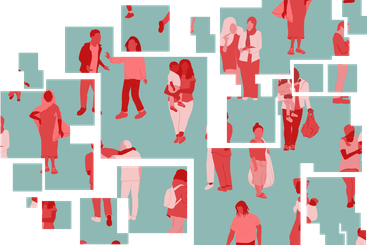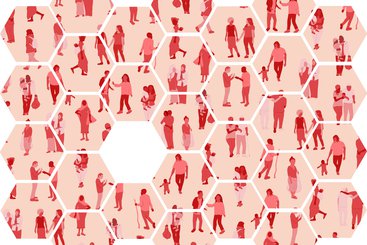Labels are powerful and political: they shape and frame how we understand ‘the story’ of displacement, as well as the ways in which refugees are perceived by others. The refugee label has long been critiqued, for many reasons.
It is imposed from above by state and aid actors and is designed to meet their policy needs and priorities, rather than those of displacement-affected communities.
Not only does the label eclipse other aspects of people’s identity, but it actively conditions and changes their identity and behaviour. People labelled as a ‘refugee’ are expected to behave or project in idealised ways that conform with refugee stereotypes, for example as innocent, helpless and passive victims.
The refugee label homogenises and does not reflect the diversity of people affected by displacement.
It is also exclusionary: by ringfencing a particular group, it excludes those (economic migrants, asylum seekers, internally displaced people) whose claims to protection are less readily accommodated within legal and political frameworks.
Stigma and stereotypes
There is another issue with the refugee label that is not well documented. It undermines social cohesion between refugees and hosts. It creates an ‘us’ and ‘them’ between refugees and hosts, which divides, ostracises and marginalises.
In Tanzania, for example, refugees are commonly referred to as ‘mkimbizi’, a derogatory term that translates as ‘those who have fled’. Associated stereotypes about refugees were extremely powerful in influencing social relations.
An Eritrean we spoke to concealed his refugee status from others: ‘The moment I mention I am a refugee, they start with all the stereotypes – refugees are perceived as criminals, bad, and with no rights.’
Concealing his status and experience has made it harder to form social bonds with others.
Some respondents changed their names and introduced themselves as Tanzanians, or married nationals to blend in. ‘We try our best to hide our refugee status to avoid mistreatment, threats and disturbances,’ explained a Burundian in Dar es Salaam.
Variations across camps, villages, settlements and cities
While stigma and stereotypes were widespread in Tanzania, these varied across the different settings in which refugees find themselves.
In camps (in western Tanzania along the border with Burundi and the Democratic Republic of the Congo) the refugee label sets refugees apart, but it also serves a useful purpose. Refugee status is a means to receiving aid and assistance, and a pathway towards resettlement.
A different picture emerged from the villages and settlements where Burundians self-settled and have lived independently for decades. For this group, the refugee label felt irrelevant and arbitrary. Many arrived in the 1970s, or were born or had inter-married in the community. Hosts also didn’t recognise long-term Burundians as refugees. They referred to them in terms of their locality (‘those from such a place’) or as ‘watarajiwa’ (prospective citizens).
Our case is not like refugees living in camp. People don’t consider us as refugees, and we don’t consider ourselves refugees. We were born and raised here. Our grandparents were refugees, not us. How can one say that I am a refugee? Refugee from where? Burundi? I don’t even know that place. I have never been there and never will go there. (25-year-old Burundian man living in Rusaba village.)
It was in urban settings that the refugee label was most problematic. Tanzania’s encampment policy prohibits refugees from leaving camps without a permit. Undocumented refugees in urban settings rightly fear the refugee label. It is dangerous. It puts them at risk of arrest and deportation, and fuels stigma and prejudice.
Rethinking the label
The international refugee regime needs to recognise the limitations of the label. Aid actors should only use it when necessary or in contexts where it is relevant and useful. They should also stay mindful of its unintended impacts on people’s identity, protection and wellbeing.
Being a refugee isn’t a barrier to social cohesion – it is the stigma attached to the label that is often the issue. If people don’t want to identify as a refugee – either because they don’t see themselves as being displaced or because it puts them in danger – it cannot be right that the label is imposed upon them.
Reading list
Burnett, K. (2013) Feeling like an outsider: a case study of refugee identity in the Czech Republic. No. Research Paper No. 251. New Issues in Refugee Research. Geneva: UNHCR (www.unhcr.org/media/feeling-outsider-case-study-refugee-identity-czech-republic-kari-burnett).
Daley, P., Kamata, N. and Singo, L. (2018) 'Undoing traceable beginnings: citizenship and belonging among former Burundian refugees in Tanzania' Migration and Society 1(2018): 22–35 (https://doi.org/10.3167/arms.2018.010104).
Hovil, L. and Kweka, O. (2008) Going home or staying home? Ending displacement for Burundian refugees in Tanzania. Citizenship and Forced Migration in the Great Lakes Region Working Paper No. 1. Dar es Salaam: Centre for the Study of Forced Migration, International Refugee Rights Initiative and Social Science Research Council (www.refworld.org/docid/53b3defa6.html).
Lee, J.-S. and Nerghes, A. (2018) ‘Refugee or migrant crisis? Labels, perceived agency, and sentiment polarity in online discussions’ Social Media + Society 4(3) (https://doi.org/10.1177/2056305118785638).
Malkki, L.H. (1995) Purity and exile: violence, memory, and national cosmology among Hutu refugees in Tanzania. Chicago, IL: University of Chicago Press.
Malkki, L. H. (1996) ‘Speechless emissaries: refugees, humanitarianism, and dehistoricization’ Cultural Anthropology 11(3): 377–404 (https://doi.org/10.1525/can.1996.11.3.02a00050).
Mann, G. (2002) ‘“Wakimbizi, wakimbizi”: Congolese refugee boys’ and girls’ perspectives on life in Dar es Salaam, Tanzania’ Environment & Urbanization 14(2): 115–122 (https://doi.org/10.1177/095624780201400209).
Forkert, K., Oliveri, F., Bhattacharyya, G., and Graham, J. (2020) ‘Nobody is born a migrant – but it’s a label people on the move struggle to escape’. The Conversation, 20 November (http://theconversation.com/nobody-is-born-a-migrant-but-its-a-label-people-on-the-move-struggle-to-escape-148574).
Scalettaris, G. (2007) ‘Refugee studies and the international refugee regime: a reflection on a desirable separation’ Refugee Survey Quarterly 26(3): 36–50 (https://doi.org/10.1093/rsq/hdi0241).
Zetter, R. (1991) ‘Labelling refugees: forming and transforming a bureaucratic identity’ Journal of Refugee Studies 4(1): 39–62 (https://doi.org/10.1093/jrs/4.1.39).
Zetter, R. (2007) ‘More labels, fewer refugees: remaking the refugee label in an era of globalization’ Journal of Refugee Studies 20(2): 172–192 (https://doi.org/10.1093/jrs/fem011).


